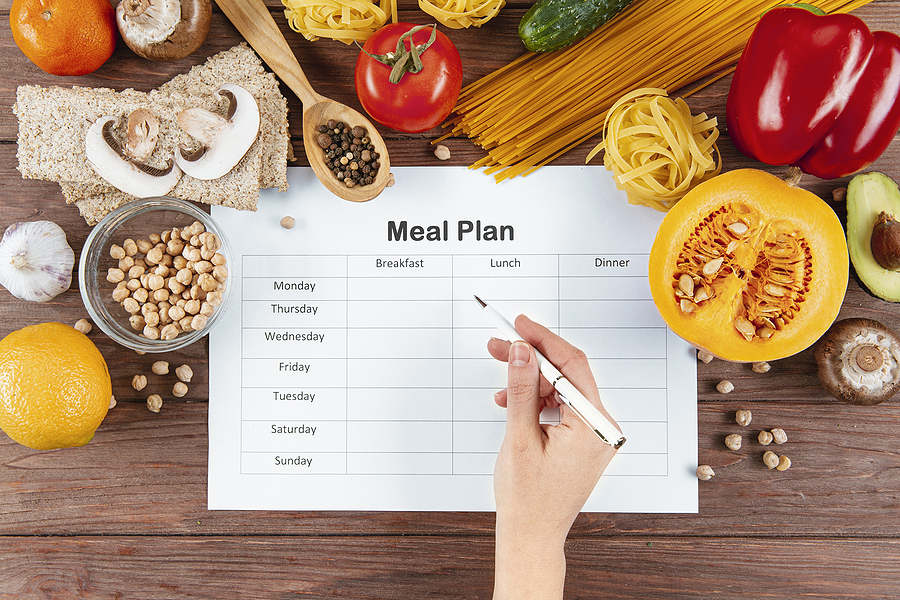If you’re struggling to juggle both a busy work week and eating healthy, meal planning will help you tremendously. Instead of wondering and getting stressed with what to cook later, you can simply refer to your week’s meal plan. It’s a simple and effective way to take the guesswork away and make things easier as you get home from work.
Moreover, meal planning allows you to experiment and try out those healthy recipes you’ve wanted to cook. With all the ingredients already available in your pantry, you can quickly whip tasty and wholesome meals. For working adults, students, and busy moms who may find themselves a bit restricted with time, getting a meal kit subscription service will be really handy. The best example is EveryPlate, which offers affordable and flexible healthy meal kits you can subscribe to so you get healthy recipes complete with all the fresh ingredients needed right at your doorstep.
Meal planning 101
While it seems like meal planning is an overwhelming task, it’s typically because you don’t have a scheme on how to tackle it.

To help you, here are simple steps to get started when meal planning today:
1. Look at your schedule
Each household’s meal plan will look different. For instance, if you’re a medical professional with shifting schedules, you have to consider your work week and decide where meal planning can serve you best.
If you’ll be going home late on particular days, you can settle with easy and healthy recipes. Alternatively, you can cook ahead, place it on the fridge, and heat it as you get home.
Moreover, if you’re a parent, take into account the times when your spouse would get home on time. If the household’s complete during Friday nights, make sure the dishes are enough for everyone.
Look into your schedule for the incoming week and factor in your availability, how many people you’ll be cooking for, or your kid’s food allergies, among other considerations. This can help you create a meal plan that perfectly fits your lifestyle and priorities.
Additionally, when you plan your meals ahead, you’re in better control of the food products and ingredients you place in your body.
2. Choose your recipes
This is where the fun part starts—choosing your meals and recipes! As you list down your recipes, take an inventory with your current fridge products, about-to expire canned goods, condiments in the pantry, and available alternative ingredients, among others. This helps you minimize waste, promotes conscientious grocery shopping, frees up pantry space, as well as allows you to use ingredients before they get bad.

Moreover, make sure to choose recipes that are fitting for the weather. If it’s rainy season, you can stock on soup, noodles, and hot pot recipes. If you haven’t done meal planning before, you can simply choose easy and quick recipes. There’s a lot of food blogs you can look into. This gives you a boost as you get into this weekly routine.
Nevertheless, if you’ve been cooking for quite a while, you can choose recipes based on weekly themes. This is a fun way to spruce up meal planning and try out healthy, tasty dishes. For instance, if you’ve been craving Asian cuisines, you can skim through digital recipes and list down appetizing and doable Asian recipes.
3. Finalize your grocery list
After you’ve narrowed down your recipe choices, it’s time to list down all the ingredients, products, and other essentials needed to make the dishes. If there are unfamiliar branded condiments and ingredients, you can always search for an alternative one that’s immediately accessible.
Upon making your list, you can categorize them to make it easy for you to look for them as you shop. For instance, group all the dairy products, condiments, canned goods, poultry, and the like.
Likewise, decide which ingredients you’re willing to spend time cutting and preparing. If you’re out of time, you can pre-cut the meat or purchase certain parts only. You can also buy pre-chopped vegetables if it’s all right with you.
Meal planning helps you buy the exact ingredients needed to prepare your chosen meals, stop purchasing extra products that aren’t going to be used immediately, and save money in the long haul.
4. Schedule your shopping day
While the weekend is typically the best time to do groceries, you can still schedule yours on your vacant time. For instance, if you’ll be working on Saturdays and Sundays, you can shop after your weekend shift or days before you get occupied.

Alternatively, if you’re too busy, you can settle with online grocery services and meal kit subscriptions. This can help you save trips from the supermarket and even support local farmers as some of these services are partnering with them. These businesses typically have pre-cut and premeasured ingredients, helping you reduce food wastes. Also, they deliver the ingredients right at your doorstep, making it convenient to stick to your meal plan.
However, if your weekends are off, definitely assign a day to shop and stick to it. This can help you easily insert grocery shopping as part of your weekly routine.
5. Be flexible
Of course, you want to stick to your plan after all your efforts, but there might be days when unexpected circumstances spring up. For instance, there might be days when you’re too exhausted, compelled to render overtime work, or friends would come over. There might also be times when you simply want to reward yourself by ordering food from your favourite restaurant.
Meal planning doesn’t entirely imply that you ought to restrict yourself from ordering food and takeouts. Instead, meal planning can partly serve as your backup plan if Thursday’s dinner out is going to be cancelled.
Meal planning should be a fun process of making sure that you’re eating right and healthy despite your rigorous routine. If you’re a beginner, you might tend to experience burnout if you don’t make room for quick revisions and experimentations. Take it slow and allow yourself to figure out what works best for you.
Final thoughts
There are different strategies and ways to introduce meal planning into your routine. By following the simple steps above, you can curate a meal plan that suits your lifestyle and needs. While you aren’t required to whip every dish, meal planning does offer you the opportunity to get back to the kitchen.

